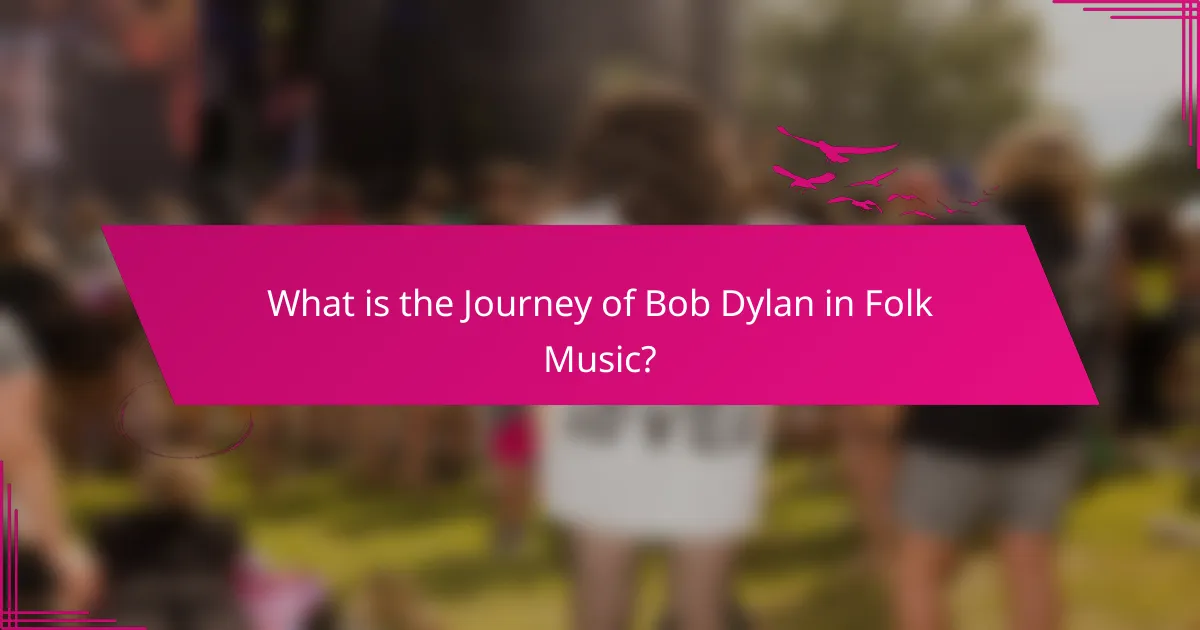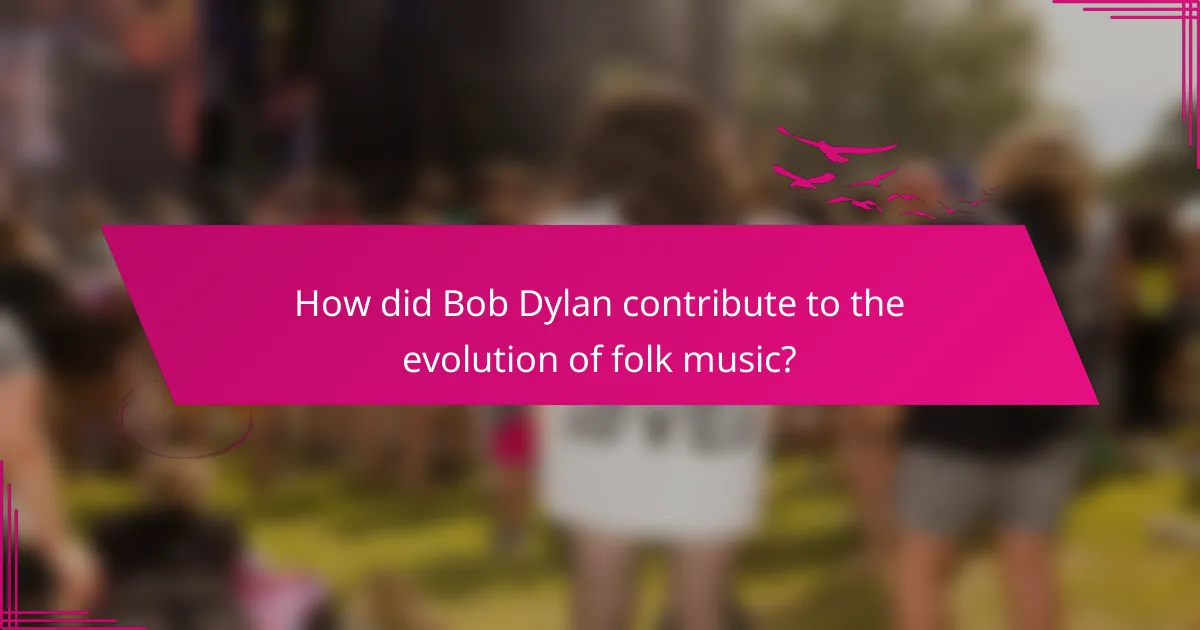Bob Dylan is a pivotal figure in the evolution of folk music, known for his profound influence on the genre and cultural commentary. His journey began in the early 1960s within the Greenwich Village folk scene, where he gained recognition for his debut album featuring traditional and original songs. Dylan’s 1963 album, “The Freewheelin’ Bob Dylan,” included the iconic protest song “Blowin’ in the Wind,” establishing him as a voice for social change. His controversial shift to electric instrumentation in 1965 at the Newport Folk Festival marked a significant turning point, blending folk with rock and blues. This transformation not only expanded the boundaries of folk music but also inspired future generations of artists, solidifying Dylan’s legacy as a cultural icon and a Nobel Prize-winning figure in literature.

What is the Journey of Bob Dylan in Folk Music?
Bob Dylan’s journey in folk music began in the early 1960s. He emerged as a prominent figure in the Greenwich Village folk scene. His debut album, released in 1962, featured traditional folk songs and original compositions. Dylan’s unique voice and poetic lyrics quickly garnered attention.
In 1963, he released “The Freewheelin’ Bob Dylan,” which included iconic songs like “Blowin’ in the Wind.” This album solidified his status as a voice of social change. Dylan’s work often addressed civil rights and anti-war themes, resonating with the youth of the era.
In 1965, he shocked the folk community by going electric at the Newport Folk Festival. This shift marked a significant evolution in his musical style. Dylan’s fusion of folk, rock, and blues expanded the genre’s boundaries. His influence on folk music remains profound, shaping future generations of artists.
How did Bob Dylan’s early life influence his music?
Bob Dylan’s early life significantly influenced his music. He was born in Duluth, Minnesota, and grew up in Hibbing. These locations exposed him to various musical styles, including folk, blues, and rock. His family background included a strong appreciation for music and literature. Dylan’s exposure to artists like Woody Guthrie shaped his songwriting approach. He also experienced the cultural shifts of the 1960s, which impacted his lyrical themes. His early experiences with social issues and personal struggles are reflected in his work. This foundation laid the groundwork for his later success as a transformative figure in music.
What significant events shaped Dylan’s upbringing?
Bob Dylan’s upbringing was significantly shaped by his early exposure to music and the cultural environment of Minnesota. He was born in Duluth, Minnesota, in 1941. His family moved to Hibbing, Minnesota, when he was young. The mining town had a rich musical heritage that influenced him. Dylan’s father was a musician, which exposed him to various musical styles. He also attended local music events, fostering his passion for folk music. The social and political climate of the 1960s further impacted his artistic development. Dylan’s experiences during this formative period laid the groundwork for his future as a cultural icon.
How did the folk scene in the 1960s impact Dylan’s career?
The folk scene in the 1960s significantly shaped Bob Dylan’s career. It provided him with a platform to showcase his songwriting talent. Influenced by folk traditions, Dylan’s music incorporated social and political themes. His early albums, like “The Freewheelin’ Bob Dylan,” gained critical acclaim and commercial success. The folk revival movement created a community that embraced his artistry. Collaborations with other folk musicians expanded his reach. Dylan’s participation in folk festivals increased his visibility. Ultimately, the folk scene positioned him as a leading voice of a generation.
What are the key milestones in Bob Dylan’s musical evolution?
Bob Dylan’s musical evolution includes several key milestones. His debut album, “Bob Dylan,” released in 1962, marked his entry into the folk music scene. The song “Blowin’ in the Wind,” from his 1963 album “The Freewheelin’ Bob Dylan,” established him as a voice of social change. In 1965, Dylan’s transition to electric music with “Like a Rolling Stone” signified a major shift in popular music. His 1966 album “Blonde on Blonde” showcased his lyrical complexity and musical diversity. The 1975 album “Blood on the Tracks” reflected personal themes and emotional depth. In 1997, “Time Out of Mind” earned him critical acclaim and a Grammy Award for Album of the Year. Each of these milestones illustrates Dylan’s adaptability and influence on music and culture.
How did Dylan’s first albums reflect the folk genre?
Dylan’s first albums reflect the folk genre through their acoustic instrumentation and lyrical storytelling. His debut album, “Bob Dylan,” featured traditional folk songs and original compositions. The use of simple guitar melodies and harmonica showcased folk music’s roots. His lyrics often addressed social issues and personal experiences, a hallmark of folk tradition. In “The Freewheelin’ Bob Dylan,” he further emphasized narrative depth with songs like “Blowin’ in the Wind.” This album incorporated elements of protest and advocacy, aligning with the folk movement of the 1960s. Dylan’s style was characterized by a blend of folk, blues, and traditional American music influences. Overall, his early work solidified his role in the folk genre and its cultural commentary.
What role did political and social commentary play in his work?
Political and social commentary was central to Bob Dylan’s work. His lyrics often addressed social injustices and political issues. Songs like “The Times They Are a-Changin'” became anthems for the civil rights movement. Dylan’s music reflected the sentiments of his generation. He used his platform to challenge authority and provoke thought. His commentary resonated with audiences seeking change. Dylan’s influence extended beyond music into cultural movements. His work remains a significant part of American protest music history.

How did Bob Dylan contribute to the evolution of folk music?
Bob Dylan significantly contributed to the evolution of folk music by introducing complex lyrical themes and electric instrumentation. His early work, such as “The Times They Are a-Changin’,” brought social and political issues to the forefront of folk music. Dylan’s shift to electric guitar in the 1960s, exemplified by his album “Highway 61 Revisited,” challenged traditional folk music norms. This transition sparked controversy but ultimately expanded the genre’s boundaries. His fusion of rock and folk influenced countless artists and led to the emergence of folk-rock. Dylan’s storytelling and poetic techniques elevated the lyrical quality of folk music. His impact is evident in the works of later musicians who adopted his style and thematic depth.
What innovations did Dylan bring to traditional folk music?
Bob Dylan introduced electric instrumentation to traditional folk music. This shift marked a significant departure from the acoustic roots of the genre. Dylan’s use of electric guitars and amplifiers changed the sound and energy of folk music. His 1965 album “Bringing It All Back Home” epitomized this transformation. The incorporation of rock elements attracted a broader audience. Dylan also infused his lyrics with complex themes and social commentary. This deepened the narrative quality of folk music. His approach inspired countless artists to explore new sounds and lyrical depth.
How did Dylan’s songwriting change the landscape of folk music?
Dylan’s songwriting revolutionized folk music by introducing complex themes and poetic lyrics. His work shifted the genre from traditional storytelling to personal and political commentary. Songs like “Blowin’ in the Wind” addressed social issues, making folk music a vehicle for activism. Dylan’s incorporation of rock elements broadened folk’s appeal to younger audiences. His 1965 album “Highway 61 Revisited” marked a departure from acoustic roots, blending genres. This fusion influenced countless artists, leading to the emergence of folk-rock. Dylan’s emphasis on lyrical depth set a new standard for songwriting in folk music. His impact is evident in the works of later musicians who adopted his style and themes.
In what ways did Dylan incorporate other genres into his folk music?
Bob Dylan incorporated other genres into his folk music through the integration of rock, blues, and country elements. His transition to electric instruments in the 1960s marked a significant shift, particularly with the album “Bringing It All Back Home.” This album blended folk with rock, featuring electric guitars and a faster tempo. Dylan’s use of blues influences can be seen in songs like “Maggie’s Farm,” which incorporates a driving rhythm and vocal style characteristic of blues music. Additionally, his exploration of country music is evident in albums such as “Nashville Skyline,” where he adopted a smoother vocal delivery and traditional country instrumentation. These genre fusions expanded the boundaries of folk music, making it more diverse and accessible.
Why is Bob Dylan considered a cultural commentator?
Bob Dylan is considered a cultural commentator due to his profound influence on music and societal issues. His lyrics often reflect the social and political climate of his time. Dylan’s songs address themes like civil rights, war, and personal freedom. For example, “The Times They Are a-Changin'” became an anthem for the 1960s social movements. His work captures the sentiments of various generations. Dylan’s ability to articulate complex emotions and societal critiques has resonated widely. He has been awarded the Nobel Prize in Literature for his contributions to cultural discourse. This recognition further solidifies his status as a significant cultural commentator.
What themes are prevalent in Dylan’s lyrics?
Bob Dylan’s lyrics frequently explore themes of social justice, love, and existentialism. Social justice is evident in songs like “The Times They Are a-Changin’,” which addresses civil rights and social upheaval. Love is a recurring theme, highlighted in tracks such as “Make You Feel My Love,” showcasing both romantic and unrequited love. Existentialism permeates his work, particularly in songs like “Like a Rolling Stone,” which reflects on identity and self-perception. Additionally, Dylan often incorporates historical and political commentary, as seen in “Hurricane,” which tells the story of wrongful imprisonment. These themes contribute to the depth and complexity of his songwriting, making his work resonate across generations.
How did Dylan’s music reflect the social issues of his time?
Dylan’s music reflected the social issues of his time by addressing themes of civil rights, war, and social justice. His song “Blowin’ in the Wind” posed rhetorical questions about peace and freedom, resonating with the civil rights movement. “The Times They Are a-Changin'” became an anthem for change during the 1960s. Dylan’s lyrics often critiqued political leaders and societal norms. His work captured the sentiments of disillusionment prevalent among youth. Songs like “Masters of War” directly confronted military and governmental authority. Dylan’s use of folk music made these issues accessible to a broad audience. His artistry contributed to a cultural shift in music as a vehicle for social commentary.

What is the lasting impact of Bob Dylan on music and culture?
Bob Dylan’s lasting impact on music and culture is profound and multifaceted. He revolutionized folk music by blending it with rock, creating a new genre. Dylan’s lyrics often addressed social and political issues, influencing generations of songwriters. His song “Blowin’ in the Wind” became an anthem for the civil rights movement. He introduced a poetic complexity to popular music that was previously unseen. Dylan’s influence extends beyond music; he has shaped literature and modern cultural discourse. His acceptance of the Nobel Prize in Literature in 2016 underscored his significance as a cultural figure. Overall, Bob Dylan’s contributions have redefined artistic expression and inspired countless artists worldwide.
How has Dylan influenced subsequent generations of musicians?
Bob Dylan has profoundly influenced subsequent generations of musicians through his innovative songwriting and cultural impact. His lyrics often blend poetic imagery with social and political commentary. This approach has inspired artists across various genres to prioritize lyrical depth. Dylan’s use of folk music as a vehicle for storytelling redefined the genre, encouraging others to explore personal and societal themes. His transition from acoustic to electric music challenged traditional boundaries, influencing rock musicians in the 1960s and beyond. Many artists, including Bruce Springsteen and Joan Baez, cite Dylan as a key influence on their work. His willingness to evolve artistically has encouraged musicians to experiment with their sound and message. Dylan’s impact is evident in the ongoing relevance of his songs, which continue to resonate with new audiences.
What specific artists cite Dylan as an inspiration?
Many artists cite Bob Dylan as an inspiration. Notable musicians include Bruce Springsteen, who has frequently acknowledged Dylan’s influence on his songwriting. Joan Baez, a contemporary of Dylan, has also credited him as a significant inspiration in her career. Additionally, artists like Neil Young and Patti Smith have spoken about how Dylan’s work shaped their music. The impact of Dylan’s lyrics and style can be seen across various genres, influencing countless musicians. His ability to blend poetry and music has left a lasting legacy in the music industry.
How has Dylan’s music been interpreted in different cultural contexts?
Dylan’s music has been interpreted in various cultural contexts, reflecting social and political movements. In the 1960s, his songs became anthems for the civil rights movement, particularly “Blowin’ in the Wind.” This song posed questions about peace and freedom, resonating with activists seeking social justice. In the folk revival scene, Dylan’s work blended traditional folk elements with contemporary issues, influencing artists globally.
In Latin America, his music was adapted to reflect local struggles, with artists like Mercedes Sosa covering his songs in Spanish. This adaptation highlighted universal themes of resistance and hope. In Europe, Dylan’s influence extended to rock and punk movements, inspiring bands to incorporate his lyrical storytelling into their music.
Additionally, Dylan’s work has been analyzed through feminist lenses, exploring themes of gender and identity in songs like “Just Like a Woman.” His ability to transcend cultural boundaries demonstrates the global impact of his music.
What lessons can we learn from Bob Dylan’s journey in music?
Bob Dylan’s journey in music teaches us the importance of authenticity and innovation. He consistently reinvented his sound, blending folk, rock, and blues. Dylan’s lyrics often reflect social issues, emphasizing the role of art in cultural commentary. His willingness to evolve demonstrates the value of adaptability in an artist’s career. By challenging norms, he inspired future generations of musicians. Dylan’s impact on the music industry illustrates the power of personal expression. His work encourages artists to address societal concerns through their art. Ultimately, his journey illustrates that true artistry requires both courage and creativity.
How can aspiring musicians apply Dylan’s approach to their art?
Aspiring musicians can apply Dylan’s approach by embracing authenticity in their songwriting. Dylan’s lyrics often reflect personal experiences and social issues. This connection to reality resonates with listeners. Musicians should also experiment with different musical styles. Dylan blended folk, rock, and blues, creating a unique sound. Moreover, they should focus on storytelling in their songs. Dylan’s narratives often convey deeper meanings and emotions. Lastly, musicians can draw inspiration from Dylan’s willingness to evolve. He continuously adapted his music and message throughout his career. This adaptability allows artists to stay relevant and true to their artistic vision.
What best practices can be drawn from Dylan’s career for cultural commentary?
Bob Dylan’s career offers several best practices for cultural commentary. First, he emphasizes the importance of authenticity. Dylan’s lyrics reflect his genuine experiences and beliefs, resonating with audiences. Second, he showcases the power of storytelling. His songs often weave narratives that capture the zeitgeist of various eras. Third, he demonstrates the impact of social and political engagement. Dylan’s work addresses pressing issues, encouraging discourse and reflection. Fourth, he embraces evolution and adaptability. Throughout his career, Dylan has reinvented his style, maintaining relevance in changing cultural landscapes. Lastly, he highlights the significance of collaboration. Dylan’s partnerships with other artists enrich his commentary and broaden perspectives. These practices can guide individuals in crafting meaningful cultural critiques.
The main entity of the article is Bob Dylan, a pivotal figure in the evolution of folk music and cultural commentary. The article outlines Dylan’s journey from his early beginnings in the 1960s Greenwich Village folk scene to his significant impact on music and society, including key milestones such as his debut album and the controversial shift to electric music. It explores how his upbringing, the folk scene of the 1960s, and his innovative songwriting shaped his career and the genre as a whole. Additionally, the article highlights the themes prevalent in Dylan’s lyrics, his influence on subsequent generations of musicians, and the lessons that can be learned from his artistic journey.